NEW ZEALAND BLOG - WEEK 6
Click on the thumbnails to see an enlarged picture.
Tuesday 24th Feb
Today's trip on Doubtful Sound more than made up for what we lost out on on the Otago trail. We were blessed with a glorious sunny day in an area that has an annual rainfall of 8-9 metres. We crossed lake Manapouri under low cloud and then took a coach over the Wilmot Pass - it was only as we reached the top of the pass that the cloud over the mountains lifted to give us a perfect view of Doubtful Sound. The Fiordland National Park is a unique area of wilderness which has been threatened in the past by the introduction of mammals by settlers. The red deer, stoats and possums destroyed vegetation and predated on the birds which were defenceless against them but now they are controlled by careful management and the ecology is recovering. During the three hour boat trip on the Sound we were privileged to see Bottle-nosed Dolphins, Fur Seals, a rare sighting of a Fiordland Crested Penguin and an Albatross. The latter was sighted as we took a trip out onto the ocean at the end of the Sound. The skipper informed us that the conditions were only favourable for venturing out this far about five days in a year on average. We were very lucky! The views were stunning too! On the way back we visited the Manapouri Power Station which was built to supply electricity for the Aluminium Smelting works at Bluff. Its situation exploits the fact that Lake Manapouri is 178 meters above sea level, the height difference providing a natural head of water which powers the turbines as it falls. It was necessary to excavate an underground cavern underneath the mountain to house the turbines. We were taken into the underground power station via a 2km long tunnel which spirals down 200 metres from above the lake. Conditions for the construction workers were difficult and dangerous and 16 men lost their lives during the 8 years it took to complete the power station. |
|
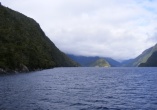 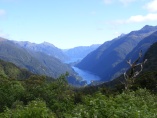 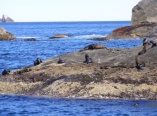 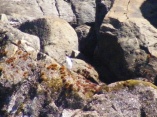 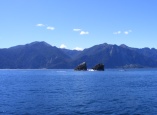 |
Wednesday 25th Feb
We left Manapouri on what is known as the Southern Scenic Route. This will take us through Invercargill and round to Dunedin by Friday evening using a coastal route in the main. The skies soon cleared and as we drove southwards we came across the Rakatu Wetland Reserve - an area bordering the Waiau River. The Waiau River drains both Lake Taupo and Lake Manapouri but since the advent of the hydroelectric scheme it has been severely reduced in volume which caused some controversy at the time the dam was built. We were to find out later that the Waiau River only carries a thirtieth of the water that it used to with obvious repercussions on flora and fauna downstream and the aim of the Rakatu Reserve is to improve and preserve the wetlands bordering the river. We next visited the Clifden Suspension Bridge, the longest of its type in NZ at 366 feet, and then moved on to the coast for lunch stopping at a rather rocky cove called Cosy Nook where we noticed how difficult it was for trees to survive. Those we saw were leaning at a crazy angle away from the prevailing wind. We arrived at Invercargill mid afternoon and spent time visiting the museum and art gallery which was excellent. A temporary exhibition of prints by artists from Papua New Guinea was a delight and there was much to see on natural history including a small area devoted to rearing the Tuatara, a type of lizard found nowhere else in the world - a relic from the dinosaur age. We'll go back tomorrow if there's time. There is a large park next to the museum, Queen's Park, which is one of the best we've ever seen. |
|
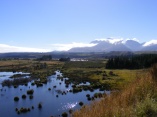 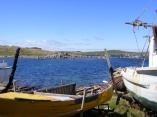 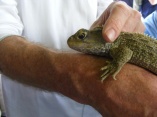 |
Thursday 26th Feb
Kept to the coast road today through 'The Catlins' - an area of wonderful views, beaches and wildlife. First stop was the small settlement of Fortrose on the edge of Toetoes Bay. It was low tide and there were many different kinds of birds feeding on the exposed areas of the beach. We were particularly pleased to see several Royal Spoonbill, a Banded Dotteril and a Black Fronted Tern - none of which we had seen before. Further round the coast at Curio Bay there is a fine example of a Jurassic Fossilised Forest on the beach and we were lucky enough to see a Yellow Eyed Penguin (Hoiho). At this time of the year they stay on the beach to moult. Just around the corner at Porpoise Bay, as we sat eating lunch, we saw a school of Hectors Dolphins swimming close to the shore. They seemed to enjoy interacting with a girl who had gone out for a swim. On the way to Pounawea we stopped for a quick visit to the Purakaunui Falls and then drove on to 'Miss Forsyth's', a motel virtually on the beachfront. As the sun was setting we went out for a walk on the beach. It was approaching low tide and wading birds were feeding at the water's edge. The air was very still and there were magnificent views and reflections as far as the eye could see. |
|
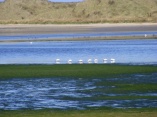 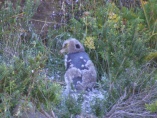 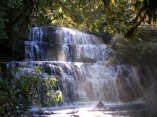 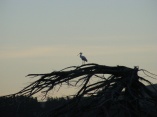 |
Friday 27th Feb
Before we left Pounawea we went for a walk round the estuary part of which went through woodland where we were followed by several Bellbirds who treated us to their early morning song. The tide was right out so we walked back along the edge of the estuary towards the beach and spotted a pair of Kingfishers. The sea was so far in the distance we could only just make out the waves on the horizon - an incredible view. Leaving Pounawea we travelled the short distance to Nugget Point where again the views were spectacular and we were able to see seals playing in the water at the base of the cliffs and Spoonbills at their nestsite We arrived in Dunedin in the early afternoon and were surprised to find out how big it is. Visited the Cathedral and the Art Gallery before making our way to the Motor Park where we were staying. Earlier in the trip we had seen an advert for a concert by Fiona Pears (violinist) which was to take place in Dunedin while we were there. We donned our best T-shirts, went along, and had a really enjoyable evening. |
|
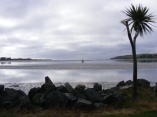 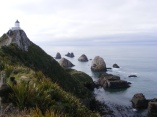 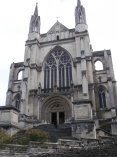 |
Saturday 28th Feb
We woke up to low cloud and mist but it wasn't raining! We had booked an early morning trip to see the Royal Albatross colony at the head of the Otago Peninsula. There were only four of us and in spite of the mist we had a good view of three nesting Albatrosses and we were able to see one of the chicks. There were Stewart Island Shags close by. Included in the trip was a visit to the fort built originally in the 1880s but later modified and used in the second world war. It houses the only in situ example of an Armstrong disappearing gun. There is a lighthouse on the tip of the peninsula and unfortunately when the gun was first tested it shattered all the windows in the lighthouse and the crockery fell off the shelves - much to the annoyance of the lighthouse keeper's wife. Pilots Beach close to the colony is a haunt of the Blue Penguin. We were fortunate to see three of these birds at close range and also have a close up view of a Fur Seal. After lunch we made our way back towards Dunedin visiting several of the remote beaches and also calling in on the Otago University Aquarium with its fine display which included a touchy feely section. We couldn't bring ourselves to touch all of the various exhibits! |
|
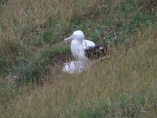 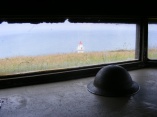 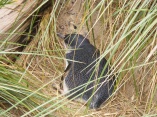 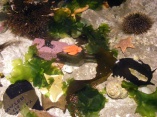 |
Sunday 1st March
It rained heavily during the night, the rivers were swollen and flowing very fast and roads were flooded in some places. We travelled up highway 1 eventually reaching Moeraki which is famous for the unusual spherical boulders on the beach. Some of them have split open revealing a different kind of reddish coloured rock in the centre. They were originally formed round a central core of carbonate of lime which attracted minerals from their surroundings. We still had a long way to go to Twizel where we were staying for the night so we carried on along the Waitaki Valley following the river and gradually climbing into wilder country. Just after Duntroon, at Takiroa, we came across some cliffs where the soft rock has been eroded into strange shapes. Here there are some examples of Maori art depicting a variery of stylised human, bird and mythological figures but they have suffered from erosion and damage from human graffiti. The final part of our journey led us past several lakes which were very 'choppy' as a result of the unsettled weather. We had gradually climbed to 500 metres above sea level, up to the tree line, by the end of the day. Twizel has the appearance of a temporary settlement - mainly holiday accommodation for those wishing to visit Mount Cook. |
|
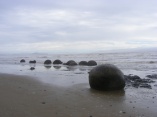 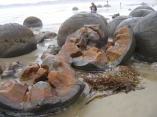 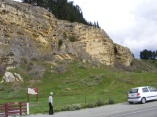 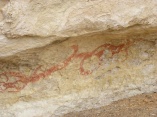 |
Monday 2nd March
We set off early to the Kaki Aviary as we had booked for a tour at 9.30am. The Kaki is another name for the Black Stilt which is seriously endangered - at one time only 23 birds were left! Introduced predators, invasion by humans and loss of habitat are the main causes of the decline. Now, with the help of a captive breeding programme, there are about 170 in the wild and 15 in captivity at the aviary. Each year the centre aims to rear 100 chicks from the eggs of both wild and captive birds. The chicks are normally released twice a year but there is still a high mortality rate. We were heading for Geraldine, passing both Lake Pukaki and Lake Tekapo on route. Both were a milky turquoise colour. The scenery was magnificent and the weather perfect with a clear sky and little cloud over the mountains - in the distance we could see the snow covered peaks of the Southern Alps. Just before we reached lake Tekapo we diverted to Mount John to see the University Observatory and from the top we could see for miles in every direction - incredibly windy though! Back down in Tekapo we visited the Church of the Good Shepherd, a tiny building right on the lakeside, built as a memorial to the pioneers of the McKenzie country in 1935, with a window beyond the pulpit which allows a clear view of the lake. The congregation is able to admire the view while listening to the sermon! |
|
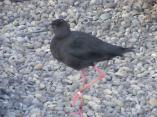 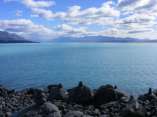 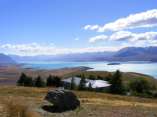 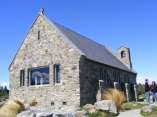 |
Return to Blog Index Goto Week 7
Page updated 4th March 2009